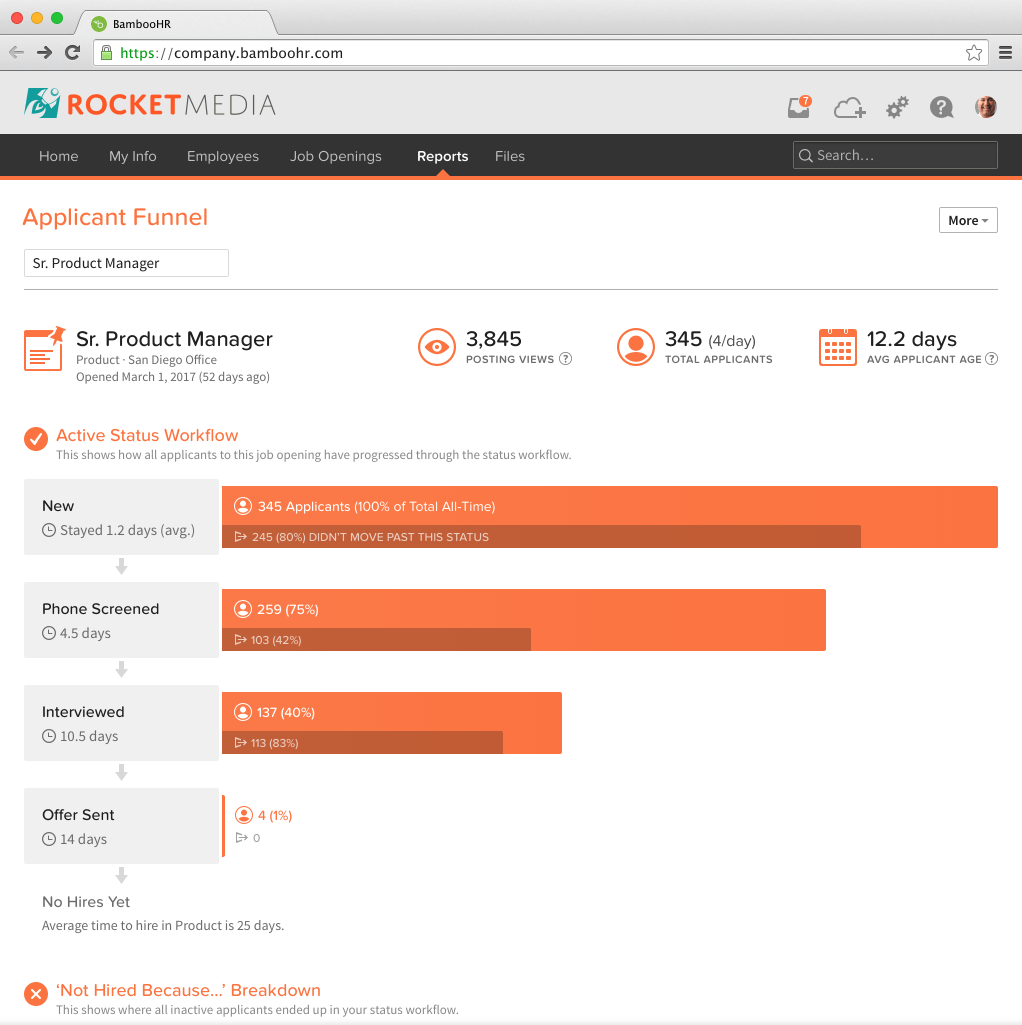HR Across Industries | How to Recruit and Retain Teachers
In this series, BambooHR compares and contrasts HR practices and challenges across a wide variety of industries. This week’s post focuses on hiring and retention issues within the education industry.
HR is challenging work no matter what organization or industry you find yourself in. But in the education industry, two challenges stand out for HR professionals and administrators above all others: recruiting and retention.
According to a report from the Learning Policy Institute, the demand for teachers started ramping up at the end of the recession; it was projected to plateau at about 300,000 teachers needed every year. At the same time, the supply of teachers has been declining for a while. Between 2009 and 2014, the number of students enrolling in teacher education programs dropped by 35 percent, from 691,000 to 451,000—this means almost 240,000 fewer teachers entered the classroom in the year 2014 as did in 2009. And things haven’t improved much in recent years.
The result? Many school districts have become desperate in the wake of this teacher shortage and have resorted to hiring people who are not fully qualified to teach; over 100,000 classrooms in 2017 were staffed by instructors who were underqualified.
Why Recruiting and Retaining Teachers is So Tough
The long-story-short of the teacher shortage is that fewer new teachers are entering the industry, more current teachers are leaving the industry, and the demand for instructors in schools remains high. That has made recruiting teachers—and more importantly—retaining teachers more difficult than ever before.
Burnout is the biggest culprit in teacher turnover, but the definition of burnout can sometimes be a little slippery. In order to get a better idea of what burnout really means in the education sector, we surveyed a handful of teachers and administrators from across the country, and they identified some of the most common burnout factors (bolded for emphasis).
- “Burnout is a result of being overworked and underpaid…if teachers don’t find support systems to guide them through, many feel like they can’t do the job right, or they see all of the expectations as ridiculous.” –Kevin D., high school teacher, California
- “It’s the lack of support from the administration and/or district. Such as when the district adopts a new curriculum but fails to buy adequate supplies to implement that curriculum. That leaves teachers to pay for supplies or ask for donations.” –Janene W., elementary school teacher, Virginia
- “The two most common causes of teacher burnout are class sizes and poor induction. New teachers need to be supported in their early years. Additionally, increasing class sizes just creates a workload for which new teachers are not prepared.” –Frank D., high school administrator, California
- “I think the most common cause of teacher burnout would be a lack of time. Sometimes I feel like I work 24/7—I am constantly rethinking and revising lessons in my head or working at home to supplement my prep time at school.” –Lauren J., middle school teacher, Utah
- “It’s easy to feel burned out when teachers receive top-down priorities with minimal regard for the reality in the classroom…there’s an overall lack of respect for the profession.” –Betsy D., high school teacher, Pennsylvania
Imagine any other employee in any other job in which they aren’t paid enough, are expected to work longer than 40 hours a week to keep up, have little support or communication from management, and must meet high performance goals that aren’t entirely in their control. If BambooHR operated that way, we wouldn’t expect the employees here to stick around for very long. Yet this is the reality—and unfortunately, the norm—for the vast majority of teachers.
So what can administrators and HR professionals do to change things in their individual schools and districts?
Teacher Recruitment Strategies
As mentioned earlier, many schools around the country are attempting to solve the teacher turnover problem by recruiting instructors who are not fully qualified. While this solves the short-term problem of putting bodies in classrooms, it does little to help with the overall shortage or reduce turnover. In fact, one study found that alternatively certified teachers (those who did not complete a four-year bachelor’s degree in education to earn their teaching license) are 25 percent more likely to leave their schools.
Instead, schools are better off hiring qualified teachers and hanging onto them. The report, “National Best Practices: Teacher Recruitment and Pipelines” from the Illinois Network of Charter Schools and the National Alliance for Public Charter Schools outlines seven best school hiring practices, which we will summarize here.
#1 Track and analyze data.
Keeping track of which hiring channels produce the most qualified candidates, how candidates experience each step of the hiring process, as well as when you expect to hire for new positions can help you organize your efforts and put your time and money to the best use. An applicant tracking system like BambooHR’s can manage a lot of this data for you automatically, making it easy to pull reports (like the applicant funnel report seen below) and understand trends at a glance.

#2 Create a calendar and start early.
Use your data to plan ahead and build a hiring plan. For example, if you can determine how many elementary teachers your school or district typically needs to hire each year, you can start recruiting efforts well before crunch time. Your plan should also include events that impact your hiring efforts, such as local university career fairs.
#3 Utilize online marketing.
Online and social marketing isn’t just for private organizations. Many candidates now use social media as part of their job search process and even more use it to research organizations they’re considering. You can use these channels to reach your target candidates and set your organization apart as a great place to work.
#4 Set up pipeline programs.
The report recommends three main pipelines for recruiting teachers: employee referral programs, internal hiring, and university partnerships. If your organization can build a smooth, efficient pipeline for each of these, you will have much better access to the best candidates. For more details, check out our other resources:
- How to Build a Successful Employee Referral Program (article)
- The Benefits of Internal Hiring (article)
- Strategic Recruiting at Any Size: 5 Programs You Can Start Building Now (webinar)
#5 Use university job fairs and career programs.
Instead of just collecting a stack of resumes at a job fair, try reaching out to specific programs within universities and colleges around you. You can host more targeted events to connect with upcoming candidates and build relationships. Not only does this help with hiring the right teachers, but it can also save you time and money you might otherwise spend at a generic career fair.
#6 Implement a rigorous hiring process.
As tempting as it is to just hire anyone to fill an emergency position, taking the time to select the right fit for the job will be much better for the school, the teacher, and the students in the long run. Use an effective interview process to weed out candidates who aren’t qualified and identify the best teachers for your organization.

#7 Build a talent community.
You can’t hire every qualified candidate. But If you provide a positive candidate experience, you can maintain good relationships with even those candidates you didn’t hire. By building up this pool of qualified individuals, you can cut your future hiring time way down because you’ll have instant access to people who may be able to fill a position. The report also suggests building a talent community by teaming up with other schools in your city. By uniting your efforts and sharing your learnings and strategies, every school in an area can benefit—especially those schools in smaller cities that don’t naturally attract a high volume of candidates.
Teacher Retention Strategies
In all the research I’ve done for this article, I’ve come across the same conclusion from experts across the board: the best way to fight teacher turnover is to prevent it from happening in the first place. Even if individual school leaders and HR professionals can’t make sweeping policy changes or transform how parents and students view education, they can still do a lot to boost employee engagement and encourage teachers to stay.
#1 Offer a competitive salary and benefits package.
A livable salary and benefits that cover basic needs are the foundation for any employee to be happy in any job. If you’ve ever seen Maslow’s hierarchy of needs, you’ll notice that psychological and safety needs form the base of the pyramid; if teachers are worried about finding a way to pay their mortgage because their pay is too low or avoiding the doctor’s office because their health benefits are poor, they won’t stick around very long, no matter how much they love being in the classroom. To learn more about competitive benefits, check out our article about the best employee benefits and perks.

#2 Build an effective onboarding process.
Among the teachers we surveyed, some explained that their onboarding or induction process added more stress to their first year instead of making it easier; others described a process that helped them become acclimated to their school and feel supported during the hectic first year of teaching. Compare these two descriptions:
- “My induction as a new teacher was more of a burden than a blessing. At a time when I was swamped with new lessons and site policies, I was overloaded with paperwork, meetings, and reports that were intended to help me acclimate to teaching, but only succeeded in making the transition more cumbersome and difficult.” –Frank D., high school administrator, California
- “The best aspect of the induction program was developing a relationship with my mentor teacher. That individual is still someone whom I look to for answers and examples, and I would never have made that deep connection without the formal mentoring program.” –Sarah S., middle school teacher, California
A common thread among those who enjoyed their onboarding experience is the presence of mentoring programs. Indeed, helping employees build relationships and connections with their peers and supervisors is a key element of any successful onboarding program. One of our own studies showed that employees who felt their onboarding was highly effective were 18 times more likely to feel highly committed to their organization. Making sure the first day, first months, and first year of a new teacher’s experience are the best they can be is crucial to long-term retention.
Check out our Definitive Guide to Successfully Onboarding Your New Employees here!
#3 Provide administrative and peer support.
When asked why they continue working at their school, the majority of the teachers surveyed said something about the support they feel from their administrators and peers. Lauren J., an elementary school teacher in Utah, explained, “I love the work environment at my school. I feel 100% supported by the administration and can count on any of my coworkers. My team works wonderfully together, and I enjoy collaborating with them.”
The Learning Policy Institute found that working for a supportive principal “can matter more than even teacher workload when it comes to decisions to stay at or leave a school.” An organizational culture of top-down administrative support combined with lateral peer support is a powerful tool for boosting teacher retention—and it’s something that administrators and HR professionals can start building today.
#4 Treat teachers like professionals.
An article in Harvard Business Review describes how teachers have come to be viewed today with less and less professionalism, as evidenced by policy and curriculum decisions being managed by people who aren’t teachers. Micromanagement and unreasonable expectations would be incredibly frustrating for any employee to deal with, and teachers are no exception.
Administrators and HR professionals can prevent this kind of frustration and burnout by treating the teachers in as experts again. At the classroom level, provide teachers with autonomy over their curriculum and classroom management, and trust them to do a great job with their students. At the administrative level, involve them in the process of setting goals and strategies so it becomes a team effort instead of only a top-down initiative. An elementary school teacher in Virginia, Janene W., echoed this idea: “When teachers feel as though they are a part of the process, they will feel a greater sense of ownership over their school, its goals, and its mission. They will feel a partnership with the administration and a greater commitment towards the school system as a whole.”
Conclusion
While these teacher recruitment and retention strategies can’t address the entire teacher shortage and turnover problem, they are key ingredients within the larger solution. Using strategic recruiting methods, providing better compensation and benefits, and building work environments that support and empower teachers—administrators and HR professionals can start working on these today to transform schools and districts across the country. And with something as foundational to our society as education, there’s no time to waste.
Get caught up every month on all things HR. Don't worry, we promise we won't spam you.
Tori Fica is a copywriter for BambooHR, the leading HR software solution for small and medium businesses. Through research, analysis, and writing, she creates content to help HR professionals think and plan more strategically. Her focus is on taking complex ideas and in-depth research and turning them into clear, digestible pieces of content.










